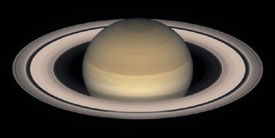
Saturn is regarded by many as the most beautiful planet in the solar system. But might there be similar gems in extrasolar systems? Astronomers will soon be working to find them. This Hubble Space Telescope image of Saturn is 'south up' to match the view in an astronomical (inverting) telescope.
Courtesy NASA and the Hubble Heritage Team.
Astronomers have the technology to detect Saturn-like rings around a planet orbiting a faraway star, and they might even learn much about the structure of a distant ring system. It is just a matter of finding one. That was the take-home message in a presentation given at an international planetary-science meeting in California earlier this month.
There are two ways that astronomers find exoplanets: they either measure the subtle back-and-forth (radial velocity) wobble that a large planet induces in its parent star, or they watch as the star's light periodically dims when a planet transits the stellar disk. The radial-velocity method gives a good orbit but leaves some uncertainty about the planet's mass. The transit method tells less about the orbit, nothing about the planet's mass, and requires a nearly perfect line of sight orientation between us, the planet, and the orbiting star. In exchange, transits reveal the planet's diameter.
NASA's Kepler mission, scheduled to launch in October 2007, is being built to spot planets all the way down to Earth-size by the transit method. And according to Jason Barnes (University of Arizona), in its quest for terrestrial planets, it should spot some ringed gems as well.
Barnes and his collaborator, Jonathan Fortney (University of Arizona) modeled what a ringed-planet transit should look like. They found that as the ring first crosses the stellar disk, the star appears slightly brighter due to the forward scattering of light from ring particles still off the star's edge. Hidden in the brightening is information about the size of the particles making up the ring. "As the planet moves across the disk, you can see the interior of the rings," adds Barnes. "You see the blockage of the ring and then the blockage of the planet."
Barnes modeled the phenomenon with a Jupiter-size body girdled by a 1.5-to-2 Jupiter-radius ring. However, he notes, many different size ring systems ought to be found. If our solar system is any indication, ringed planets are common. Each of the solar system's gas giants has rings — Saturn's are simply the widest and most visible.
Spotting an extrasolar Saturn could happen even before Kepler goes online. The most famous transiting planet, HD 209458b, showed no evidence of a ring in a very precise light curve of a transit taken with the Hubble Space Telescope. Says Barnes, "Hubble could have seen a ring in the HD 209458 transit had it been there."
 0
0
Comments
You must be logged in to post a comment.